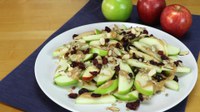Prairie Fare: How About Some Apple Nachos?
(Click an image below to view a high-resolution image that can be downloaded)
By Julie Garden-Robinson, Food and Nutrition Specialist
NDSU Extension Service
“I plan to make apple nachos for dessert,” I said to my 18-year-old daughter, who was taking a break from college food that evening.
She looked at me for a couple of seconds. I think she was deciding whether she heard me correctly. She likes nachos, but I think I threw her for a loop by including “apple” in the same phrase.
“Well, that sounds interesting,” she said in a noncommittal way.
“I tried them already, and they are very good,” I added.
She nodded and grinned. I tried not to read her mind, but she probably was thinking, “Yeah, sure, Mom, you made tasty nachos without chips and cheese.”
“I am going to pick some apples to bring back to the dorm,” she said. I think she noticed our backyard apple tree was laden with the red, juicy fruit.
I was glad to hear she likes apples because they are an excellent snack. They can be used in a variety of ways beyond the typical pies, crisps and turnovers that people popularly make at this time of the year.
Try making chunky apple sauce or dehydrated apples, which are naturally sweet and low in fat. By the way, you can find directions to prepare a variety of apple recipes by searching the recipe section on the NDSU Extension Service food website (https://www.ag.ndsu.edu/food).
We each crunch and munch our way through about 44 pounds of apples per year. The top five most purchased apple varieties are Gala, Red Delicious, Fuji, Granny Smith and Honeycrisp, according to the U.S. Apple Association.
Regardless of your favorite variety, apples often are the symbol of nutrition for a good reason. Besides their delicious flavor and versatility, apples are an excellent source of soluble fiber. Apple pectin is a soluble fiber that can help lower our LDL (bad) blood cholesterol levels.
Apples also are a good source of vitamin C, potassium and magnesium. Be sure to eat the peeling because it is rich in disease-fighting antioxidant compounds and fiber.
Researchers have linked apples to health benefits, including reducing our risk for stroke, helping with diabetes management and losing weight. Much of the research points to the natural antioxidants and fiber in apples as reasons for the benefits.
This fall, as we enjoy the beautiful red, gold and orange leaves dancing in the air, be sure to include a variety of colors on your plate. The American Heart Association recently launched the “+color” campaign to increase awareness of the benefits of adding more fruits and vegetables to our diets.
In fact, making this one change could save 39,900 lives and $7.6 billion in medical costs annually.
Often we in the nutrition field suggest that you “subtract” things from your diet, but this time, we are suggesting an addition. Add more colorful fruits and vegetables to your diet. In fact, fresh, canned and dried fruits and vegetables count toward the 4 to 5 cups of fruits and vegetables recommended daily.
Here’s a tasty recipe courtesy of the American Heart Association’s Simple Cooking with Heart program (http://www.heart.org/simplecooking). Use your favorite type of apple and invite kids or grandkids to help you assemble the ingredients.
Note that the recipe calls for heart-healthy unsalted nuts and seeds and unsweetened dried fruit. The nuts and seeds provide healthful fats and the dried cranberries contribute additional antioxidant nutrients. You can be creative and substitute other dried fruit, nuts, pumpkin seeds or unsweetened shredded coconut.
Here are my notes: I used two red apples and one green apple for a visually appealing dish. Because I made the recipe ahead of time, I dipped the apples in a solution of a commercial antioxidant (Fruit Fresh), which is high in ascorbic acid (vitamin C). I added a little extra hot water to thin the peanut butter more. You also can use fresh or bottled lemon juice to help prevent browning, as noted in the recipe.
By the way, my sometimes skeptical daughter enjoyed the recipe a lot.
Apple Nachos
1/3 c. dried, unsweetened cranberries or raisins
1/4 c. sliced almonds, unsalted
2 Tbsp. hulled, unsalted sunflower seeds
3 medium apples (red or green), cored and thinly sliced (about 12 pieces per apple)
1 to 2 tsp. lemon juice
2 Tbsp. hot water
1/4 c. reduced-fat, smooth peanut butter
1 Tbsp. honey
In a small bowl, combine dried cranberries/raisins, almonds and sunflower seeds. Core each apple and thinly slice into about 12 pieces each. Layer half of the apples onto a large plate or platter. If the apple slices will be sitting out for a while, sprinkle with lemon juice to prevent browning. Using a microwave oven or teapot, bring 2 tablespoons of water to a boil. In a small bowl, combine hot water, peanut butter and honey. Use a spoon and stir until mixture is smooth. Use a spoon to drizzle the peanut butter mixture over the plated apple slices; sprinkle with half the cranberry mixture. Layer the remaining apples on top and repeat with remaining peanut butter and cranberry mixture. Serve.
Makes eight servings. Each serving has 167 calories, 7.4 grams (g) fat, 4 g protein, 22 g carbohydrate, 4 g fiber and 66 milligrams sodium.
(Julie Garden-Robinson, Ph.D., R.D., L.R.D., is a North Dakota State University Extension Service food and nutrition specialist and professor in the Department of Health, Nutrition and Exercise Sciences.)
NDSU Agriculture Communication - Oct. 6, 2016
| Source: | Julie Garden-Robinson, 701-231-7187, julie.garden-robinson@ndsu.edu |
|---|---|
| Editor: | Ellen Crawford, 701-231-5391, ellen.crawford@ndsu.edu |



